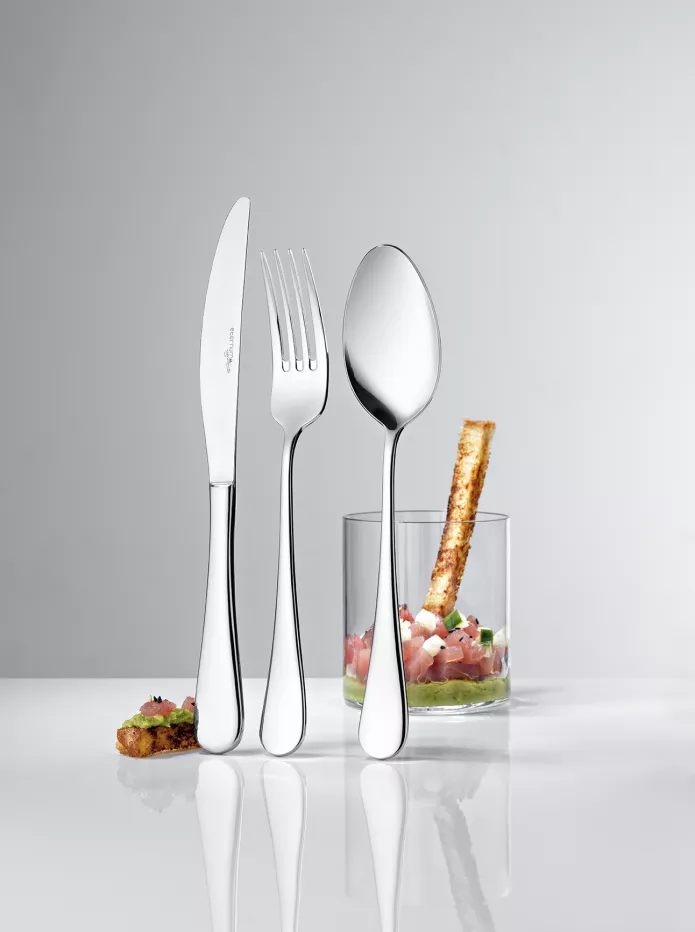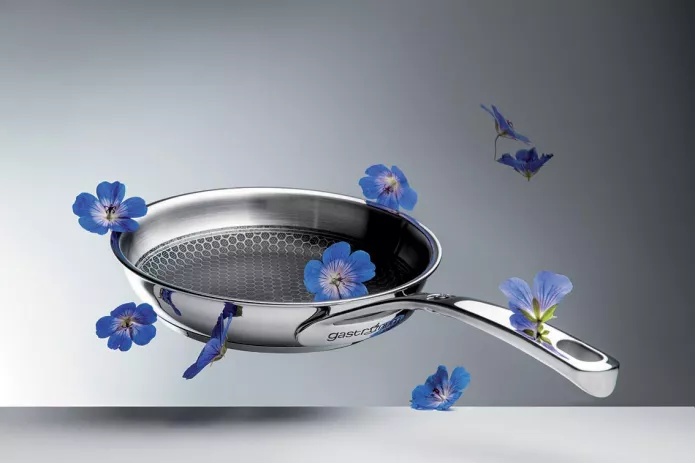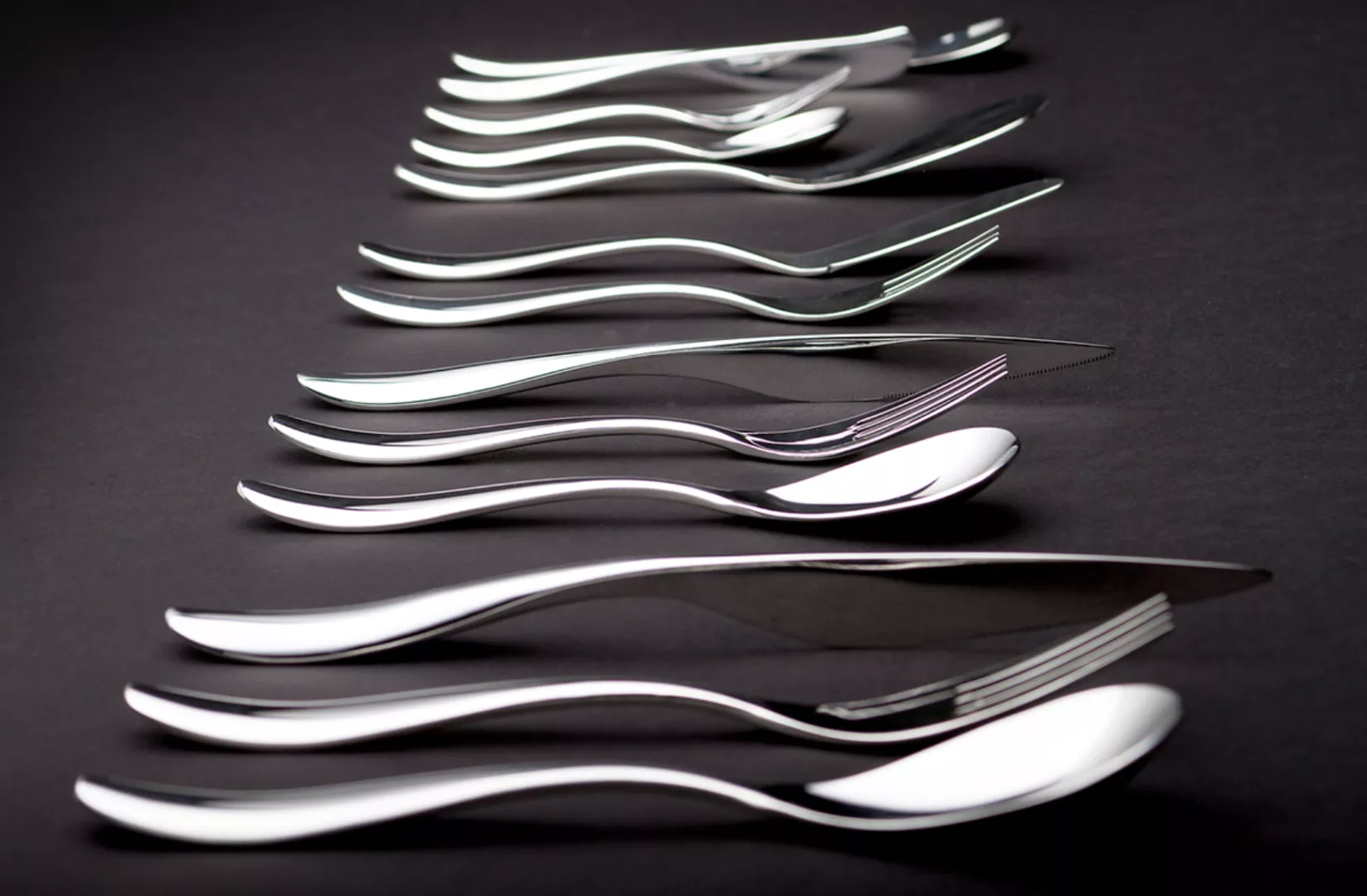
Cutlery maintenance
How to avoid scratching your cutlery?
Like any metal, stainless steel can get scratched or damaged when it comes into contact with other stainless steel items or harder materials. Here are our tips to protect your cutlery:
- Gentle Handling:
- Avoid grabbing multiple pieces of cutlery at once, causing them to knock against each other.
- Never throw cutlery into storage bins.
- Dishwasher Organization:
- Place cutlery vertically in the dedicated compartments of the dishwasher. This minimizes shocks caused by water jets and prevents scratches.
- Sort cutlery by type: for example, separate dessert forks from table spoons to avoid fork prongs scratching surfaces.
Cutlery Care During and After Washing:
- Quick Washing:
Clean cutlery as soon as possible after use, especially knives or items made of different steel from 18/10 stainless steel (like Young series or knives). This reduces the corrosive effect of food acids.
- During the Washing Cycle:
- Optimal Rinsing: Rinsing should remove all food residues and detergent traces. A vertical arrangement of cutlery, with the heads facing up and no overloading, facilitates this.
- Knife Precautions: Although some manufacturers advise against placing knives in the dishwasher, proper practice and adherence to guidelines minimise risks.
- After Washing:
- Effective Drying: Rapid drying can leave spots with chemical residues that risk corroding 18/10 steel or knives. If the dishwasher ends its cycle in a warm, humid atmosphere, open the door immediately to release moisture. Some models have an automatic opening feature for this reason.
- Avoid Standing Water: When water doesn’t drain completely, it can damage the steel and leave persistent marks.
Professional Use Maintenance
In professional settings, there are specialized machines to automatically dry cutlery after dishwashing:
- These machines use vibrations and corn residues to dry and lightly polish cutlery.
- This process reduces visible scratches and maintains the metal’s shine.
By following these tips, your stainless steel cutlery will remain shiny, durable, and elegant for your guests.

How to care for your PVD-coated cutlery
Care for Your Colored Cutlery with PVD Coating
Your cutlery is made of high-quality stainless steel (18/0 and 18/10), food-safe, and coated with a PVD (Physical Vapor Deposition) titanium layer that gives it vibrant colors. Although dishwasher-safe, we recommend hand washing to preserve its shine. Follow the guidelines below to keep your cutlery as radiant as when purchased.
Care Instructions :
Hand Washing
- Before first use: Thoroughly wash your cutlery by hand.
- Preserving shine: Hand washing is preferred to maintain its brilliance. Use a soft sponge and non-abrasive detergent, avoiding scouring pads, chlorine-based, or sodium-based detergents.
- Rinse quickly: Clean or rinse immediately after use to prevent damage from prolonged exposure to salty or acidic foods (mayonnaise, vinegar, broth, etc.).
- Drying: Never leave your cutlery to soak. After washing, dry immediately with a soft cloth.
Dishwasher Washing
Dishwasher use is possible if you follow these guidelines:
- Mild detergent: Use a detergent with a phosphate content below 3%, without chlorine or sodium.
- Low-temperature program: Opt for low-temperature cycles (40 °C or less) or eco-programs.
- Pre-rinse: Remove acidic or salty food residues before placing the cutlery in the dishwasher.
- Positioning: Place cutlery in the basket with handles facing down to avoid them touching (especially spoons).
- Material separation: Do not mix stainless steel cutlery with silverware or cutlery made of inferior steel, as this can cause scratches or chemical reactions.
- After washing: Remove cutlery as soon as the cycle ends, and dry immediately with a soft cloth to avoid stains or water marks. Never leave cutlery in a closed or humid dishwasher.

Care and Use Instructions for Gastropans
Before the first use:
Wash Thoroughly: Wash the non-stick pan with warm, soapy water before its first use. Rinse and dry it completely.
General Use:
Use Low to Medium Heat: Non-stick pans are most effective at low to medium heat settings. Avoid using high heat, as it can damage the non-stick coating over time.
Use the Right Utensils: Use silicone, wooden, or plastic utensils to avoid scratching the non-stick surface. Metal utensils can damage the coating and reduce its effectiveness.
Avoid Cooking Sprays: While non-stick cooking sprays may seem convenient, they can leave a residue that builds up on the pan over time. Instead, use a small amount of oil (fit for high heat cooking) or butter for cooking.
Preheat Carefully: Preheat the pan on low to medium heat before adding ingredients. Overheating an empty non-stick pan can cause damage to the coating.
Use Non-Abrasive Cleaning Tools: After each use, clean the pan with a soft sponge or cloth. Avoid abrasive scouring pads or steel wool, as they can scratch and damage the non-stick coating.
Always lift cookware from the hob. Never drag or slide it, as this can damage the surface.
Cleaning and Maintenance:
Remove Stains Promptly: If food or stains accumulate on the surface, soak the pan in warm, soapy water for a short period before cleaning. Stubborn stains can often be gently scrubbed with a non-abrasive pad.
Store Properly: To prevent scratches, stack non-stick pans with a soft cloth or paper towel between them. Store pans in a cool, dry place.
Warnings:
Avoid High Heat: Using high heat can cause the non-stick coating to deteriorate over time & discoloration to the frying pan or hob surface. Stick to low to medium heat settings for best results.
Inspect Regularly: Check the condition of the non-stick coating regularly. If you notice any signs of peeling or damage, consider replacing the pan to maintain food safety.
By following these care and use instructions, you can extend the life of your non-stick pans and ensure they remain a reliable tool in your kitchen.
Warranty
- 2 years on non-stick material.
- 10 years on stove construction.
This warranty covers defects in materials and workmanship encountered during normal use of the stove. It excludes any damage resulting from misuse, abuse, negligence, accident, modifications, normal wear and tear or failure to follow the product's care and use instructions.
